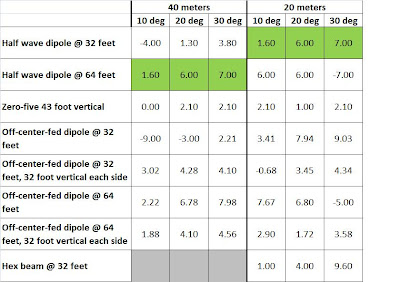I am moving locations! The new QTH as of the end of October (just in time for CQ WW SSB!) will be about 70 km West of my current location. We are moving due to wife's job, so that her commute is reduced from an hour to just 15 minutes (the GOLDEN RULE of marriage: if Momma is happy, everybody is happy!)
Looks like more land to play with for antennas, a LOT more trees, and nobody behind me at the back end of the property.
I still have some CC&R to deal with, but stealth antennas have always been my standard.
So what to do in terms of antenna design? As the sunspots continue to disappoint, my primary bands are 20 and 40 meters (I do get on 30 occasionally, but just to work a new DXCC entity).
In my antenna portfolio, I have the following:
1. Zero-Five 43 foot vertical with remote tuner
2. Buckmaster 135 foot off-center-fed dipole (Not the BuxComm antenna)
3. Hex-beam 2 element yagi for 20 meters
4. Center-fed half-wave dipoles for 20 and 40 meters
So, when analyzing the problem as an engineer the first question I ask is "What is it that I am trying to achieve?" If you look at my home page, you can see that I have just over 250 DXCC worked and just under that number confirmed. Not bad, but not honor-roll worthy. Since I only have 100 watts to play with (for now), I need the best radiators that I can get.
What determines best? Looking at my DXCC tally, I see a lack of long-distance DX into Southeast Asia. This is confirmed by looking at my log books. For whatever reason, my current QTH does not measure up on the SE Asia path. What to do?
Well, I should be able to work them, but I suspect a hill to the North is reflecting much of my signal. The new QTH won't have that problem. But what about the right antennas for the job?
With the mix I have listed above, I can add another twist. If I drop to vertical position the last 32 feet of each end on the off-center-fed dipole, I will add an equivalent of two quarter-wave active elements on 40 meters that are spaced a half-wavelength apart. BINGO! That will give me some gain broadside on 40, if the antenna is at 32 feet. A nice and simple mod, especially considering that the flat version of the antenna at 32 feet is basically NVIS/radiating at high angles.
Back to the task at hand. What do I need to reach SE Asia? Let's look at some ARRL data for angle-of-arrival statistics. The graphs below show the percentage of time that the RF signal arrives at a particular angle, for all hours and days over the entire 11 year sunspot cycle. The graphs show for both 20 and 40 meters:


What can we conclude from these graphs? How low can we go, is the real question. The angles of arrival are VERY low. The radiation pattern needs to be below 30 degrees to work DX, as a general rule of thumb. These graphs show that the angle of radiation needs to be below 10 degrees to realistically get into SE Asia. That's a real challenge. I cannot put a yagi at 100 feet, so I will need to get creative. And I don't want to lose my 30 degree radiation arrival angles for EU (not shown here).
I did some calcs with EZNEC, used real ground reflection coefficients, and came up with the following table. The values to beat as the standard are shown in gree, the baseline half wave dipole at a half wavelength in height. The values in the table are in dBi.

Conclusions:
The off-center-fed dipole at 64 feet would give me that radiation at the lower angles for 20 meters. (What I am not showing here is the azimuthal pattern which is for the next post). Suffice it to say that 7.67 dbi at 10 degrees is pretty darn good for what I am trying to achieve. It comes with a cost, though - a HUGE null at 30 degrees. I can compensate that by using the hex beam at 32 feet to fill in that hole.
For 40 meters, it looks like the off-center-fed dipole at 32 feet, with the vertical legs for the last 32 feet, still beats out everything else for RF at 10 degrees elevation. The vertical is close second.
So, it looks like I will be putting up the off-center-fed Buckmaster at 64 feet, the hex beam at 32 feet, and another Buckmaster at 32 feet with the vertical "tails" option. Finally, I will put up the Zero-Five vertical with a good radial field All I need to do is figure out what direction to orient the off-center fed dipoles by looking at their azimuth pattern, and get a pneumatic tennis ball launcher/antenna raising device for the higher trees.
Like Anthony Michael Hall said in the 1984 flick "16 Candles"
"This...is getting good."


it's a really nice blog thanks for add my comment...
ReplyDeletePlay you bingo games, learn how to play bingo, online bingo games with us and if you want to read bingo rules and all about bingo games then click on www.yourbingogame.com and get fun all your bingo games.Your Bingo Game
it's a really nice blog thanks for add my comment...
ReplyDeleteSuper Betting Guide, this is a place where you can learn casino betting tips, online gambling, betting guide, how to play blackjack, casino betting, betting tips and many more. Betting Tips
Nice stuff dear. I like it China antenna manufacturers & broadband antenna manufacturers
ReplyDelete